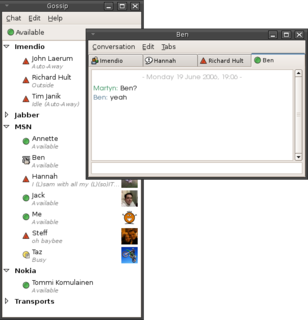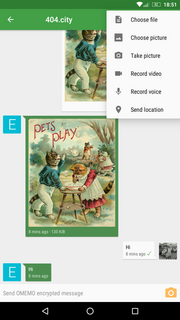
AIM was an instant messaging and presence computer program created by AOL, which used the proprietary OSCAR instant messaging protocol and the TOC protocol to allow registered users to communicate in real time.

Instant messaging (IM) technology is a type of online chat allowing real-time text transmission over the Internet or another computer network. Messages are typically transmitted between two or more parties, when each user inputs text and triggers a transmission to the recipient(s), who are all connected on a common network. It differs from email in that conversations over instant messaging happen in real-time. Most modern IM applications use push technology and also add other features such as emojis, file transfer, chatbots, voice over IP, or video chat capabilities.

Pidgin is a free and open-source multi-platform instant messaging client, based on a library named libpurple that has support for many instant messaging protocols, allowing the user to simultaneously log in to various services from a single application, with a single interface for both popular and obsolete protocols, thus avoiding the hassle of having to deal with a new software for each device and protocol.

Extensible Messaging and Presence Protocol is an open communication protocol designed for instant messaging (IM), presence information, and contact list maintenance. Based on XML, it enables the near-real-time exchange of structured data between two or more network entities. Designed to be extensible, the protocol offers a multitude of applications beyond traditional IM in the broader realm of message-oriented middleware, including signalling for VoIP, video, file transfer, gaming and other uses.

Yahoo! Messenger was an advertisement-supported instant messaging client and associated protocol provided by Yahoo!. Yahoo! Messenger was provided free of charge and could be downloaded and used with a generic "Yahoo ID" which also allowed access to other Yahoo! services, such as Yahoo! Mail. The service also offered VoIP, file transfers, webcam hosting, a text messaging service, and chat rooms in various categories.

BitlBee is a cross-platform IRC instant messaging gateway, licensed under the terms of the GNU General Public License.
The following is a comparison of instant messaging protocols. It contains basic general information about the protocols.
A LAN Messenger is an instant messaging program for computers designed for use within a single local area network (LAN).

Empathy is an instant messaging (IM) and voice over IP (VoIP) client which supports text, voice, video, file transfers, and inter-application communication over various IM communication protocols.

Jami is a SIP-compatible distributed peer-to-peer softphone and SIP-based instant messenger for Linux, Microsoft Windows, OS X, iOS, and Android. Jami was developed and maintained by the Canadian company Savoir-faire Linux, and with the help of a global community of users and contributors, Jami positions itself as a potential free Skype replacement.
Secure instant messaging is a form of instant messaging. Both terms refer to an informal means for computer users to exchange messages commonly referred to as "chats". Instant messaging can be compared to texting as opposed to making a mobile phone call. In the case of messaging, it is like the short form of emailing. Secure instant messaging is a specialized form of instant messaging that along with other differences, encrypts and decrypts the contents of the messages such that only the actual users can understand them.

Tox is a peer-to-peer instant-messaging and video-calling protocol that offers end-to-end encryption. The stated goal of the project is to provide secure yet easily accessible communication for everyone. A reference implementation of the protocol is published as free and open-source software under the terms of the GNU GPL-3.0-or-later.
TextSecure was an encrypted messaging application for Android that was developed from 2010 to 2015. It was a predecessor to Signal and the first application to use the Signal Protocol, which has since been implemented into WhatsApp and other applications. TextSecure used end-to-end encryption to secure the transmission of text messages, group messages, attachments and media messages to other TextSecure users.
The following is a general comparison of notable XMPP clients, which are instant messaging designed for decentralized, standardized, extensible, interoperable, federated, network using the XMPP protocol, which are open standard.
Threema is a paid and proprietary end-to-end encrypted instant messaging service. Clients for iOS and Android are available.
Ricochet or Ricochet IM is a free software, multi-platform, instant messaging software project originally developed by John Brooks and later adopted as the official instant messaging client project of the Invisible.im group. A goal of the Invisible.im group is to help people maintain privacy by developing a "metadata free" instant messaging client.

Matrix is an open standard and communication protocol for real-time communication. It aims to make real-time communication work seamlessly between different service providers, in the way that standard Simple Mail Transfer Protocol email currently does for store-and-forward email service, by allowing users with accounts at one communications service provider to communicate with users of a different service provider via online chat, voice over IP, and videotelephony. It therefore serves a similar purpose to protocols like XMPP, but is not based on any existing communication protocol.
The Signal Protocol is a non-federated cryptographic protocol that can be used to provide end-to-end encryption for voice calls and instant messaging conversations. The protocol was developed by Open Whisper Systems in 2013 and was first introduced in the open-source TextSecure app, which later became Signal. Several closed-source applications have implemented the protocol, such as WhatsApp, which is said to encrypt the conversations of "more than a billion people worldwide" or Google who provides end-to-end encryption by default to all RCS-based conversations between users of their Messages app for one-to-one conversations. Facebook Messenger also say they offer the protocol for optional Secret Conversations, as does Skype for its Private Conversations.
Wire is an encrypted communication and collaboration app created by Wire Swiss. It is available for iOS, Android, Windows, macOS, Linux, and web browsers such as Firefox. Wire offers a collaboration suite featuring messenger, voice calls, video calls, conference calls, file-sharing, and external collaboration – all protected by a secure end-to-end-encryption. Wire offers three solutions built on its security technology: Wire Pro – which offers Wire's collaboration feature for businesses, Wire Enterprise – includes Wire Pro capabilities with added features for large-scale or regulated organizations, and Wire Red – the on-demand crisis collaboration suite. They also offer Wire Personal, which is a secure messaging app for personal use.

Conversations is a free software, instant messaging client application software for Android. It is largely based on recognized open standards such as the Extensible Messaging and Presence Protocol (XMPP) and Transport Layer Security (TLS).










